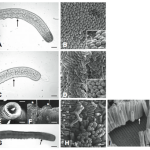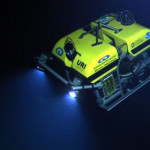We asked Jeff Drazen, the exuberant doctor in the video, to pass along his comments about the encounter. The video is credit to Eric Vetter, Craig Smith, and HURL.
From Drazen: This video of a 16-18 ft long six-gill shark, Hexanchus griseus, was filmed from the PICES submersible (operated by HURL) at 1000m depth north of the Hawaiian island of Molokai. The dive was part of a project led by Eric Vetter (Hawaii Pacific University) and Craig Smith (UH).
Eric Vetter, Max Cremer and myself were in the sub at the time. We were conducting a bait experiment to examine scavenger abundance and diversity. The lights were off and we were talking when I though I felt the sub move. Max checked his instruments and confirmed that we were still on the seafloor. I peered out of the porthole and noticed that something was moving in front of the red lasers (used for estimating size of animals in the video). Max turned on the lights and you know the rest from the video.
The six gill shark is distributed worldwide in waters temperate and tropical oceans. It was previously known from Hawaii but its biology here, or elsewhere, is almost unknown. We observed these sharks on every dive done on the north coast of Molokai Island. Thus they appear to be fairly common residents. It is amazing to think that a population of these large sharks so near to the coast (we have very steep slopes here) has gone unnoticed by the Hawaiian public. But then again it just reflects how little studied the deep sea is, and highlights the need for more study.
Craig and Eric’s project has studied the influence of canyons on benthic communities. They have discovered that the canyons in Hawaii channel terrestrial detritus which enriches the sediment community. In turn they have found increased abundances of benthic animals and scavengers such as shrimp. The six gill sharks were observed at bait experiments designed to study the scavengers. In short they have found that the canyons are biological hotspots relative to other areas of the island slopes.
The manned submersible operations team at the Hawaii Undersea Research Lab (HURL) originally posted the video and we are all delighted by the great public response. Since 1982 they have been committed to assisting science groups from all over the world in the study of processes and organisms in the deep ocean, and it is not often that we are rewarded with a spectacular encounter like this.
Share the post "Follow Up to the 1m (3.3ft) Wide Shark Head With 17 Ft (5.2m) of Shark Love To Follow"





